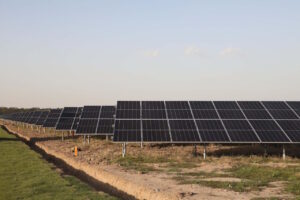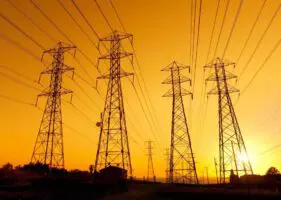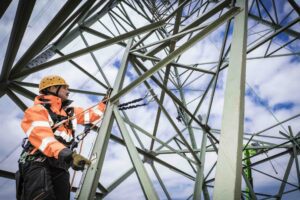Companies in the Pilbara need to think bigger if Australia is to achieve both emissions reductions goals and if they want to capitalise on an annual $250 billion green iron opportunity, says a new report.
Miners and oil and gas companies need to accelerate plans to share their energy infrastructure and create a single common-user electricity grid, says the Superpowering Up report from think tank Climate Energy Finance (CEF).
Ending the feudal approach to energy infrastructure in the Pilbara, where every company builds and owns generation and grids on their own patch, there is scope to add the estimated $50-100 billion of extra renewable energy generation needed to decarbonise Australia’s biggest mining region.
“We need a system level change in ambition and scale and that is going to require common user infrastructure rather than a piecemeal approach,” says CEF director Tim Buckley.
“We’re recommending turning over miners’ energy infrastructure to common use by giving it to someone, via long term power purchase agreements, who really knows what they’re doing and stays focused on it.”
Getting trucks off diesel
Part of the puzzle is electrifying transport, as the report found that only 2 per cent of energy use in the Pilbara is renewable.
The vast majority, or 2.4 billion litres a year, is in the form of diesel which is heavily subsidised by the federal government.
Replacing that requires new electricity generation of 16.66 terawatt hours (TWh) a year, equivalent to 7.8 per cent of Australia’s National Electricity Market (NEM).
Buckley says while some miners, such as Rio Tinto and Fortescue – which aims for “real zero” in its Pilbara operations by 2030 – are doing well on decarbonisation planning, others such as BHP are falling short.
“When BHP talks about a 50 per cent reduction in electricity emissions by 2025, they forget to mention that diesel is 60 per cent of their emissions in the Pilbara and electricity is 11 per cent. So they’re making a whole lot of noise about how they are reducing electricity but they’re ignoring the elephant in the room,” he says.
“Effectively, we’re seeing about a 1 per cent annual reduction in total emissions.”
Furthermore, transport decarbonisation plans are moving so slowly as to almost be going backwards.
Rio’s and RBHP’s big media splash about electric trucks trials are only for two vehicles at a time, and Hancock’s big pink electric locomotive was unveiled – in the US – last year but no word has been spoken about it arriving in Australia yet.
“An electric haulage system is what they’re targeting but they’re targeting 5 or 10 years too slowly,” Buckley says.
The report proposes capping the federal Fuel Tax Credit Scheme at $50m pa per company, but reinvest the $14 billion or so raised by 2030 back into those companies via a rebate for capital investments made on decarbonising transport.
“We have been very focused on turning the diesel fuel subsidy from a headwind into a tailwind for decarbonisation,” Buckley says.
“It is unlikely that BHP and RIO are going to accelerate their electrification and decarbonisation of their mine haulage fleet whilst they’re each booking $500 million in subsidies each year to not do it.”
Lean into green iron
Allowing miners to refocus on their core business of digging up minerals and outsourcing energy management to an expert is what is needed to green the Pilbara.
An expert could navigate the particular conditions that make joining up the disparate Pilbara energy grids and generation – and ensuring it’s all firmed – in ways that miners cannot.
What it will take is serious federal and state government support to change the dynamics in the region, says CEF analyst and the report author Matt Pollard.
“The Pilbara has a significant challenge in building out large-scale infrastructure such as the transmission grid and renewable energy capacity given its harsh conditions, isolated location and high-cost labour market,” he says.
“Our recommendations include strategic national-interest public investment under the Future Made in Australia Act to catalyse private capital investment into a common-user infrastructure and create economies of scale; streamlined approvals for grid and clean energy infrastructure; and First Nations equity participation in energy project developments.”
Failing to invest now could be severely problematic for resource-dependent Australia, as nations which buy those minerals begin to look for green versions from the likes of Brazil, he says.
The threat is of Asian trading partners decarbonising their steel industries. The Pilbara is a source of low-grade, high-impurity haematite, but if this could be sold as “green iron ore”, suddenly it could become much more valuable.
Starting with common infrastructure will solve the currently heroic problem of how to build out enough renewable energy supplies to turn iron ore green.
Some of the report’s recommendations include creating an Overriding Public Interest principle, as Europe has done, to overcome barriers and delays, and expedite approvals for renewable energy.
It also calls on the federal government to urgently prioritise the Pilbara for strategic national-interest public investment under its Future Made in Australia Act, to crowd in private finance, and spend some of the Clean Energy Finance Corporation’s (CEFC) $3 billion in concessional financing already committed to Western Australia.
That kind of money is also needed to overcome another problem created by miners in the Pilbara: extremely high cost labour.
In terms of a renewables-powered grid, this could be solved by making everything outside the region and simply shipping it in and installing, such as the 5B operating model, or channelling ambition such as the then-Asian Renewable Hub once proposed to set up a wind turbine manufacturing facility in the region.
Embrace big ideas
The report’s core idea, of spurring on a green iron export industry, could also be helped along with a $10 billion production tax incentive, much as has been designed for the nascent hydrogen industry.
Other tips include advocating for an Asian Carbon Border Adjustment Mechanism (CBAM) which would promote the development of green exports, and even follow Indonesia’s lead by mandating that all minerals must have some kind of value-add before being exported.
But what could be most powerful is the call for miners to leverage their balance sheets in the name of decarbonisation.
Buckley says this could be done by putting their energy assets into infrastructure funds and opening those to moneyed investors, such as super funds.
Then turning those over to an expert, such as a BP or an APA which recently spent $1.8 billion buying up Alinta’s Pilbara energy assets, to manage.










